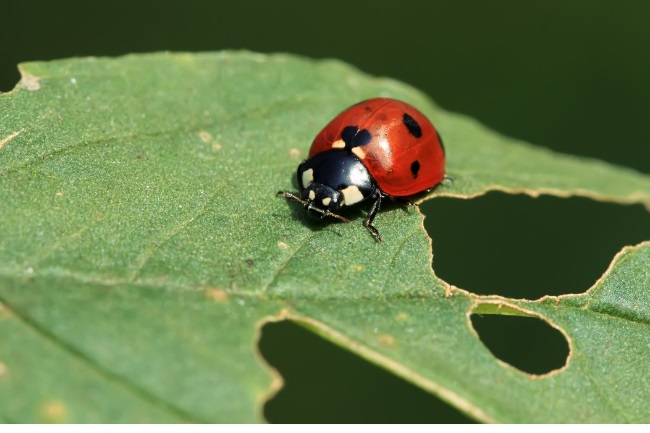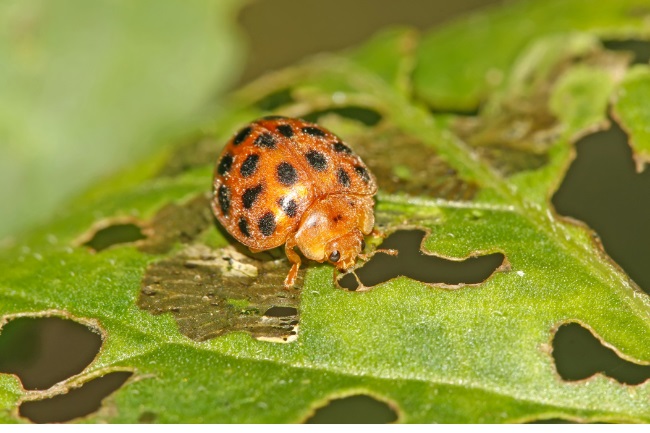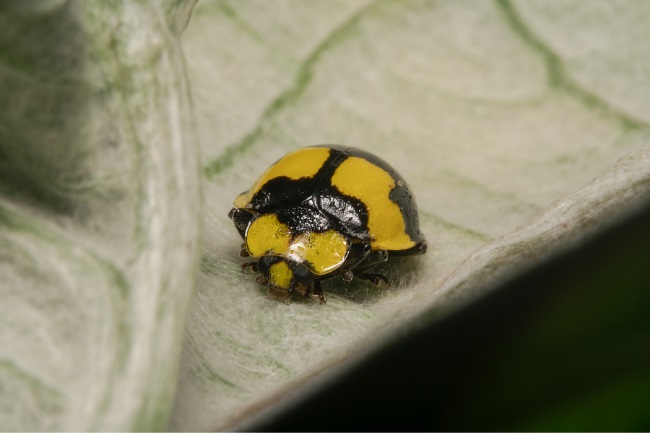Around 90% of the over 5,000 species of ladybugs that live across the globe are thought to eat aphids and other damaging pests. However, many suppliment their diets with small amounts of plant matter, such as nectar. A very small number of ladybugs are entirely herbivourous, eating only plants.
Contents
The very hungry omnivore
Many people are inclined to worry when they see large numbers of insects on a plant. This is because we tend to associate groups of insects with infestations. This hasn’t been helped by the negative representation of many species in the media, with reports often using overly dramatic language such as ‘killer swarm’ or ‘plague.’ Even ladybugs are portrayed as a negative thing whenever they turn up in large numbers, leading many people to assume they must be doing harm. Yet, the majority of ladybugs are here to help us in our gardening and agriculture, rather than damage what we’re so carefully reared.
Ladybugs are often found gathered together, either because they’re in their winter dormancy or because they have found a good source of food. Ladybug larvae are also mostly found in groups, as many eggs can be laid on one plant. Because of their resemblance to caterpillars or other grubs, many people can be confused about what species they might be related to, and assume they’re feasting on the plant, when in fact, they’re eating the pests that are eating the plant. It’s therefore important to know what these helpful ladybugs look like at all stages of their lifecycle, so they can be encouraged rather than exterminated.

The vast majority of ladybugs eat aphids, scale bugs, and whitefly, all species which we as gardeners and food producers, would like to see less of. However, like many insects, ladybugs will take advantage of other food sources every now and then, to help diversify their diet. Many species have been found to eat some nectar and pollen, but examinations of their stomachs have also found other plant matter.
It could be that they have simply taken in whatever the species of insects they were eating happened to have in their stomachs. Still, they also might be taking a nibble every now and then to take advantage of specific vitamins and minerals not provided for in their regular meals.
| Ladybug Species | Plant Diet |
|---|---|
| Seven-Spotted Ladybug | Aphids, scale insects, mealybugs, mites |
| Convergent Ladybug | Aphids, scale insects, mealybugs, mites |
| Asian Lady Beetle | Aphids, scale insects, mealybugs, mites |
| Two-Spotted Ladybug | Aphids, scale insects, mealybugs, mites |
| Cream-Streaked Ladybug | Aphids, scale insects, mealybugs, mites |
Many insectivorous animals are believed to have started out eating plants but accidentally or purposefully comsumed insects on the plants at the same time. Until eventually the increased energy they received from the insects caused them to shift to a more meat-heavy diet. This means that the majority of ladybugs, that take in plant matter as well as insects, would be categorised as omnivores, the same as us humans. Most species do this to a relatively small extent, whilst some regularly consume fungi or vegetation as part of their diets. However, ladybugs species that primarily eat aphids, and other pests, do not eat enough plant matter to cause any significant damage.
The amount of benefit they give from eating the aphids far outweighing the harm they do with the odd nibble of a cabbage-leaf.
Herbivorous Ladybugs
Whilst the vast majority of ladybugs concentrate their time on plant pests there are some ladybugs that do eat a purely vegetarian diet. In the animal kingdom the word for this is herbivorous. Some of these are significant crop pests and cause a great deal of damage in the places where they are found.
Arguably the most famous is the Mexican bean beetle (Epilachna varivestis), so disliked that it seems it’s been downgraded from a ‘lady’ to just a plain old ‘beetle’. This small copper-coloured beetle, with plentiful black spots, feasts on legumes and is the enemy of farmers of crops such as lima bean and soybean. It is believed to have originated in Mexico but is now found throughout the eastern United States all the way up to Canada. It likes moist climates, so luckily will not spread into drier areasThe damage caused by the Mexican bean beetle is extensive and very distinctive. Though it feeds on all parts of the plants, the leaves are the most affected, with a lace-like pattern left behind.

The larvae cause the most damage, though both adults and larvae will feed on the plant. Similar is true for the much larger Squash beetle (Epilachna borealis). The Squash beetle is a yellowy-orange beetle with large black spots. Its larvae are particularly dramatic to look at, their fat yellow bodies covered in large black spines. As the name suggests, the squash beetle focuses on squashes and other members of the gourd family, such as melons.
Whilst it may not be a popular guest in any vegetable patch the large leafeating ladybug (Papuaepilachna guttatopustulata) certainly is exciting to look at. With a black elytra and red and orange spots it would certainly be a firm favourite if it wasn’t so set on eating solanaceous plants, such as potatoes and tomatoes. Endemic to Australiasia it’s certainly one that no one is keen to introduce to new countries.
Fungivorous Ladybugs
While not officially herbivores many people tend to group insects that eat fungi with plant-eaters. Officially called fungivores, these insects might eat mildews or molds, or even feast on larger mushrooms. The twenty-two spot ladybugs (Psyllobora vigintiduopunctata) is a lovely ladybug, with its bright yellow elytra and many black spots. Its food of choice might seem less appealing to us, as it enjoys feasting on mildew, focusing specifically on those that grow in shrubs and umbellifers like cow parsley.
The fungus-eating ladybug (Illei galbula) is another fungivorous ladybug, as you may have guessed from its unimaginative name. It has adapted mouth-parts to help scrape the fungal mass from the surface of the leaves. Another wonderfully yellow ladybug, it has a series of zigzagging lines across its elytra, which make it more eye-catching and appealing than it’s name might have you think.

The similar, but more traditionally marked, sixteen-spot ladybug (Tytthaspis sedecimpunctata) combines the best of two worlds, enjoying a mixture of fungi, pollen and nectar in its diet. It is often found on grasslands, particularly within plants such as nettles and dandelion. Its pale yellow elytra is divided in two by a thick black line, with large yellow dots arranged symetrically on either wing.
Whilst tales of rampaging flocks of hungry herbivore ladybirds, out to desimate your vegetable garden, might have you reaching for the insecticide, it’s worth remembering that the vast majority of ladybird are going to help your garden thrive. And even those that do have unpleasant intentions are still a part of the food-web. Maybe if you do find that your squash leaves are under attack it’s worth looking for who you could encourage into your garden that might enjoy a tasty ladybug snack. Perhaps it’s about time to start putting up a few bird boxes by your house.

